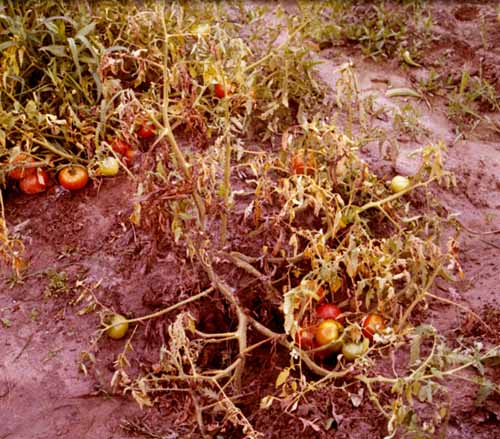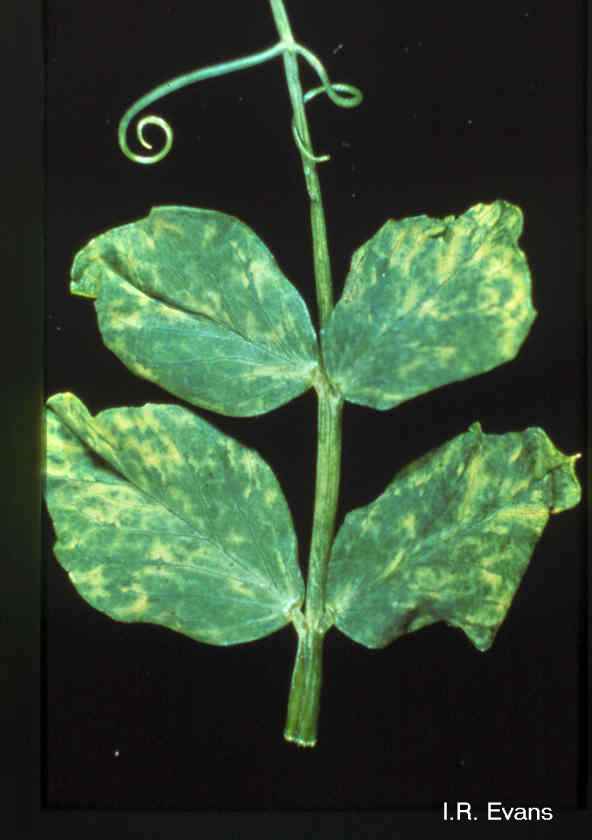The monsoon has been extra zealous this year. You may have heard about it already, and if you are living in certain parts of India, may have experienced it already. In Maharashtra, especially in Wardha, it has been raining non stop - the precipitation till July is already double than what is observed in a normal monsoon.
On the experimental farm, we are working on problems related to water logging, especially in fields where crops are standing. There is a marked increase in plant diseases. Fusarium wilt disease in on rise, and so is the yellow mosaic virus of pulses. Girdle beetles are making their presence felt too.
Fusarium wilt is a fungal disease and affects a number of herbs. Those that are most commonly targetted by the fungus are legumes, cucurbits, tomato, potato, and some other members of the family Solanaceae. The fungus is omnipresent in the soil but gets a boost in warm and moist soil conditions. It enters the the plant through the vasculature in root tips and migrates to different parts of the body. The process is similar to how a pathogen enters human blood stream and migrates to different parts of the body resulting into a rapid spread. The fungus and its spores ultimately cause the clogging of the vasculature, bringing the transport of water and nutrients inside the plants to a halt, eventually causing the wilt. Using resistant varieties, mixed-cropping techniques, crop rotations and proper drainage of the field are few of the solutions to control the disease.
Yellow mosaic virus commonly affects pulses, but can target a wide variety of crops. The virus can get transmitted to the plant either through whiteflies and aphids while they are sucking on the plant sap, or through the infected seeds. The symptoms depend on the plant species or variety, but most common symptoms are yellowing of leaves, apical necrosis which results in stunted growth, mottling of leaves, yellowing of veins, etc. It's a dreadful disease since yields can decrease by as much as 95%. Using resistant varieties, mixed-cropping techniques, crop rotations and using seeds from disease-free fields fields are few of the solutions to control the disease.
Girdle beetles feed on the foliage and flowers of the crops and cause sizeable damage. As the photosynthesis efficiency of the plant decreases, it lags behind, resulting into late and low productivity. Mixed cropping techniques and crop rotations are effective measures against the beetles. In chemical agriculture, pesticides are obvious choices to contain the problem, but we wholeheartedly believe in organic farming. The solutions hence, are more prophylactic than curative in case of girdle beetles.
Coming to the connection between rainfall and the diseases, there is a direct link between rainfall and Fusarium wilt. We need more data to establish with confidence that there is a connection between amount of rainfall and incidence of YMV and of the beetles. Right now it is a correlational evidence at best.
On the experimental farm, we are working on problems related to water logging, especially in fields where crops are standing. There is a marked increase in plant diseases. Fusarium wilt disease in on rise, and so is the yellow mosaic virus of pulses. Girdle beetles are making their presence felt too.
Fusarium wilt is a fungal disease and affects a number of herbs. Those that are most commonly targetted by the fungus are legumes, cucurbits, tomato, potato, and some other members of the family Solanaceae. The fungus is omnipresent in the soil but gets a boost in warm and moist soil conditions. It enters the the plant through the vasculature in root tips and migrates to different parts of the body. The process is similar to how a pathogen enters human blood stream and migrates to different parts of the body resulting into a rapid spread. The fungus and its spores ultimately cause the clogging of the vasculature, bringing the transport of water and nutrients inside the plants to a halt, eventually causing the wilt. Using resistant varieties, mixed-cropping techniques, crop rotations and proper drainage of the field are few of the solutions to control the disease.
 |
| Fusarium wilt |
 | ||||||||||||||||||||||||||||||||||||||||||||||||||||||||||||||||||||||||||||||||||||||||||||||||||||||||||||||||||||||||||||||||||
| Yellow Mosaic Virus. Both images courtesy Google Images | . |
Coming to the connection between rainfall and the diseases, there is a direct link between rainfall and Fusarium wilt. We need more data to establish with confidence that there is a connection between amount of rainfall and incidence of YMV and of the beetles. Right now it is a correlational evidence at best.
No comments:
Post a Comment